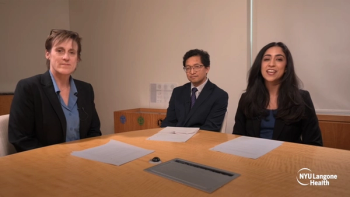
Eyecon 2024: What every OD and MD should know about geographic atrophy
David Chin Yee, MD, sat down with Ophthalmology Times to discuss his presentation on what every Optometrist and Ophthalmologist should know about geographic atrophy at Eyecon 2024.
David Chin Yee, MD, sat down with Ophthalmology Times to discuss his presentation on what every Optometrist and Ophthalmologist should know about geographic atrophy at Eyecon 2024.
Video Transcript:
Editor's note: The below transcript has been lightly edited for clarity.
David Hutton:
Hi. I'm David Hutton of Ophthalmology Times. The Ophthalmology Times/Optometry Times EyeCon 2024 event is taking place at the Hilton Fort Lauderdale Marina on September 27 and 28, 2024, At the event, Dr. David Chin Yee presented "GA: What Every OD Should Know." Thank you so much for joining us. First, tell us about the key points of your presentation.
David Chin Yee, MD:
Thank you for having me. The key point is helping to kind of educate how to suspect the patients with geographic atrophy, what imaging modalities and tools are out there to kind of help to identify the findings that we would classically find ... going over and reviewing whether it's fundus photography, optical coherence tomography or OCT, or using fundus autofluorescence. One, again, to identify these lesions and also use it as a tool to educate patients on what the symptoms may appear as, and also be able to kind of educate the patients and what geographic atrophy actually is. We also briefly go over, you know, what geographic atrophy is and how quickly it progresses, making sure that it's understood that, unfortunately, it's a relentless, irreversible disease process that, thankfully now, for the first time, we have new treatment options which serve to slow down the progression, right. And it's important to understand, unfortunately, we don't have a way to reverse it. We're not stopping it. But the idea is, slowly, you know, to slow down the progression of this devastating disease process, which we now know as geographic atrophy.
David Hutton:
What are the most critical signs and symptoms that ophthalmologists and optometrists alike should look for detecting the early stages of GA?
David Chin Yee, MD:
Yeah, you know, it's not similar in some of macular degeneration. What we look for, usually, is that the patient will note loss of central vision, specifically identified on the Snellen visual acuity. But patients with GA, a lot of times, they will notice findings a lot sooner. Specifically, their reading speed can be diminished, right. And so, a lot of our patients with macular degeneration, unfortunately, they also have difficulties with hearing and so they rely heavily on subtitles. And they will find that with the subtitles, their reading speed is decreased. So, they're not able to catch up and read the subtitles before they disappear. So that would be one finding. The other issue is difficulty in low light settings. So, their lights, low luminance or ability to read in low or dim lighting has been noted to be decreased, and that is also something that they will identify and notice. So, if they go to a nice restaurant, it's a candlelight dining, they will have the need to want to take out their flashlight or their phone to make it brighter for them to be able to read or see what they could have seen years prior before having this problem.
David Hutton:
What role can optometrists play in monitoring disease progression in GA and how often should they be reevaluating patients?
David Chin Yee, MD:
Yes. So again, which we touched on, is having some of these findings or identifying these lesions, whether it be on OCT, or on fundus photo or fundus autofluorescence. These patients first need to be identified, know that they have this problem, and then be monitored a lot more frequently. Routinely, macular degeneration patients, we would follow up 6 months to once a year. Now, with patients having geographic atrophy, we like to tell them, see them at least every 3 months.
David Hutton:
Are there any emerging therapies or technologies on the horizon for GA that both ophthalmologists and optometrists should keep their eyes on?
David Chin Yee, MD:
Yeah, thankfully, you know this is the first class of medication that we have focusing on complement inhibition to slow down the progression. But we do have other treatments — some that are going to be subcutaneous, some in the form of gene therapy — that look to be promising. And the hope is, with these newer treatment and technology, will be able to maybe stop or even reverse or improve vision in the future.
Newsletter
Don’t miss out—get Ophthalmology Times updates on the latest clinical advancements and expert interviews, straight to your inbox.













































